Excerpts from Jim Conrad's
Naturalist Newsletter
entry dated September 12, 2022, issued from near Tequisquiapan, elevation about 1,900m (6200 ft), N20.565°, W99.890°, Querétaro state, MÉXICO
EDIBLE AGARICUS MUSHROOMS
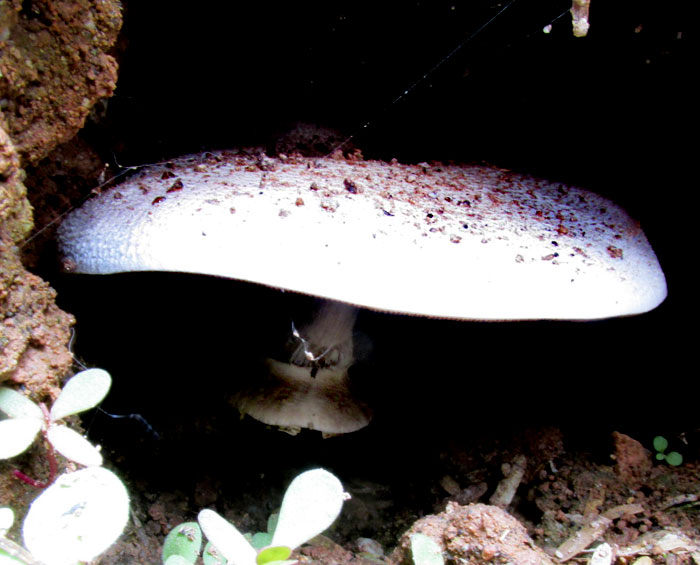
A friend raises rabbits in a large pen with a dirt slope. The rabbits, though of domesticated races, retain enough wild instincts to dig deep burrows into the soil, where they like to nest. At the entrance of an old burrow grew the above all-white mushroom.
The mushroom's cap was about 10cm across (4 inches). The brown flecks on the top are pieces of dirt fallen from the burrow's ceiling. The cap rises on a fairly thick stem on which there's a conspicuous ring, or annulus. You might want to check out general mushroom features and names of parts on our Mushroom Identification page. This mushroom's ring was so well formed that I placed the camera below the mushroom's cap and in the darkness took the time exposure photo shown below:
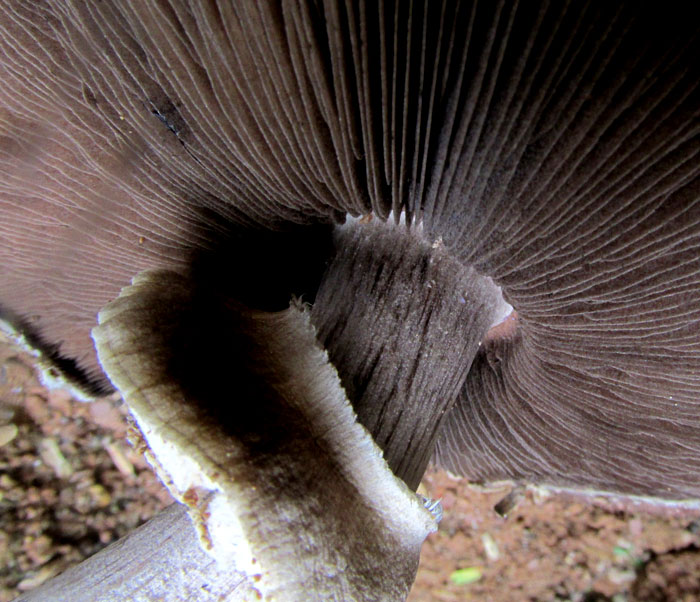
In that picture it's clear that the ring is completely separated from the stem, and is just hanging there. The ring is what remains of the "partial veil," which on many mushrooms temporarily covers and protects the gills as they are developing. The gills are the very thin vane-like items radiating from the stem's top. Gill surfaces are coated with millions of club-shaped "basidia," from which bud reproductive spores. Spores falling from the gills are carried by air currents to new places where they might germinate and form new fungi.
The picture also shows that the gills stop short of attaching directly to the stem, or even continuing down the stem, as in the case with some mushrooms. That's an important feature to note for identification, as is the mere fact that there's a ring, for many mushroom species don't produce rings. Nor do many species have gills. When the mushroom was tilted forward, its cap could be photographed:
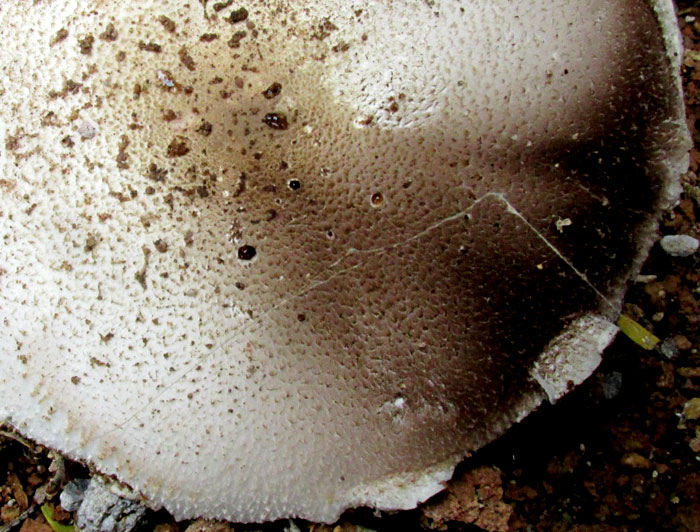
Above, it's clear that besides dirt fallen onto the cap, there are other sources of the cap's brown tinge. The brown smudge on the cap at the right surely consists of brown spores deposited there by a curious circulation of air at the burrow's mouth. Also notice that the cap's surface displays what appears to be hints of very small, scale-like growths.
This matter of the spores being brown is important, because one of the most useful field marks a mushroom has is its spore color. Spore colors can range from black to white, with many in-between shades possible, but spore color is consistent within a species. When I first saw that our rabbit-hole mushroom's stem bore such a well defined ring, I immediately thought the mushroom might be a deadly Amanita. However, Amanita mushrooms produce white spores. Since I wanted to be sure about the color of our rabbit-hole mushroom's spores, I broke off a small piece of cap with spore-producing gills on the bottom, and atop a piece of paper, by leaving overnight the cap fragment with its gill side facing downward, got the "spore print" shown below:
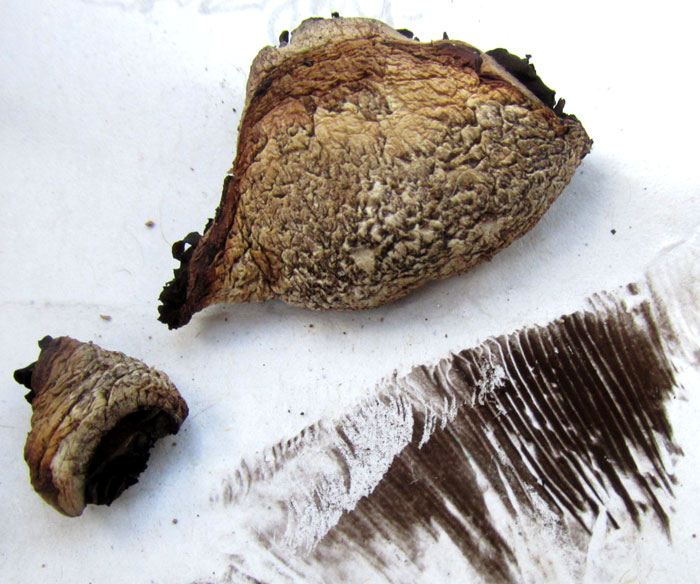
At the picture's lower, right, you can see how each gill dropped thousands of brown spores. Also, the chunk of mushroom cap at the picture's top shows that as the cap dries its scaly features turn brownish.
If you have a mushroom with a fair-sized but not too large cap, a ring on a thickish stem, gills that don't attach to the stem, brown spores, and it's growing on the ground, it's a very good bet that you have the genus Agaricus. And if you like to eat wild mushrooms, having an Agaricus is good news, because this genus is home to several favorites of mushroom eaters.
However, if you want to eat your mushrooms, you need to be certain about the identification, so identifying your mushroom as an Agaricus is just the beginning. Of the genus's 300-odd species, some are highly edible but others are poisonous. Michael Kuo, who produces the wonderful MushroomExpert.Com website, quote's the world's top expert on North American Agaricus, Richard Kerrigan, as saying that when identifying Agaricus species "... [t]here may be cases where the very best solution presently available will be to say that 'this specimen is very close to . . .' and if you learn to live with that, I expect that you will be happier while studying Agaricus." You might enjoy trying to identify our above Agaricus, or your own, on Kuo's The Genus Agaricus page, which includes a "Key to 100 Agaricus species, subspecies, and varieties in North America."
When I attempted to identify our mushroom with Kuo's key, I ran into a wall when I needed to know how long in µms the spores were. However, the key narrowed down the possibilities to a handful of species, pictures of which could be looked up on the Internet. Using that technique, I came to be somewhat sure that our rabbit-hole mushroom was, or was very close to, AGARICUS CAMPESTRIS, commonly known as the Field Mushroom.
Normally Field Mushrooms turn up after rains in grassy areas, especially well manured ones. The species is a decomposer fungus, so it thrives on lots of organic matter. Our rabbit burrow in fill dirt doesn't seem to match that requirement, except for this: In that area, in the past, rabbit manure mixed with oat straw, from beneath the rabbits' feeding cages and sleeping shelters, has been buried by the bucketful. By now, that manure must be home to massive networks of fungal hyphae, which can come together to form mushrooms.
I read that Field Mushrooms, Agaricus campestris, are "nearly identical (except microscopically) to the edible species Agaricus andrewii and A. solidipes." Plus, very little, or no, literature is available detailing the subtle differences between Field Mushrooms and other species that might appear in upland central Mexico. However, our cool, temperate climate is similar to parts of North America where Field Mushrooms are common, our mushroom appeared a few days after a good rain, and mushroom spores travel very great distances on the wind, so there's not reason why a Field Mushroom shouldn't pop up here at a rabbit hole.
At the same time our rabbit-hole mushroom appeared, I traveled to the mountains of western Querétaro, to visit a friend in San Pedro Huimilpan, near the border with Michoacán, at about 2400m in elevation (7900ft). My friend tended a grassy orchard which was well manured, and emerging from the grass were more white mushrooms than anyone wanted to collect. Below is a picture of some:
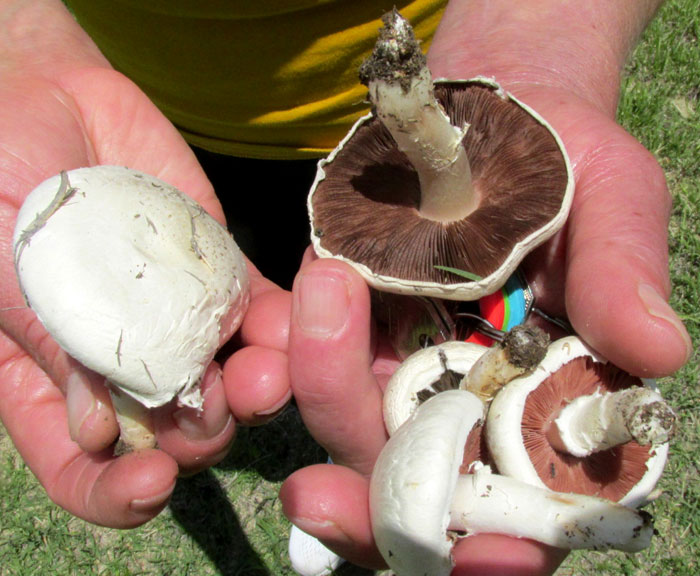
My friend called this species Champiñón, which in English we call Champignon, from the French Champignon. Don't forget that the French ruled Mexico through Maximilian I from 1864-1867, during which time French influence made its impression, especially in the haute cuisine of central Mexico. Wikipedia offers an interesting Maximilian I of Mexico page. Maximilian was killed by firing squad near here in Querétaro city.
My friend didn't need to go through any identification process to know that this was the delicious Champiñón her father taught her to collect and eat when she was a child. Every year she picks Champiñones from the same field she always has. And this is the kind of person who makes the best teacher of which mushrooms to eat, and how, and when.
However, the moment you shift to a new region or new environment, your knowledge of local mushroom lore no longer is completely trustworthy. New look-alike and maybe toxic species may be in this new place, and then, as I must, you'd best "do the botany."